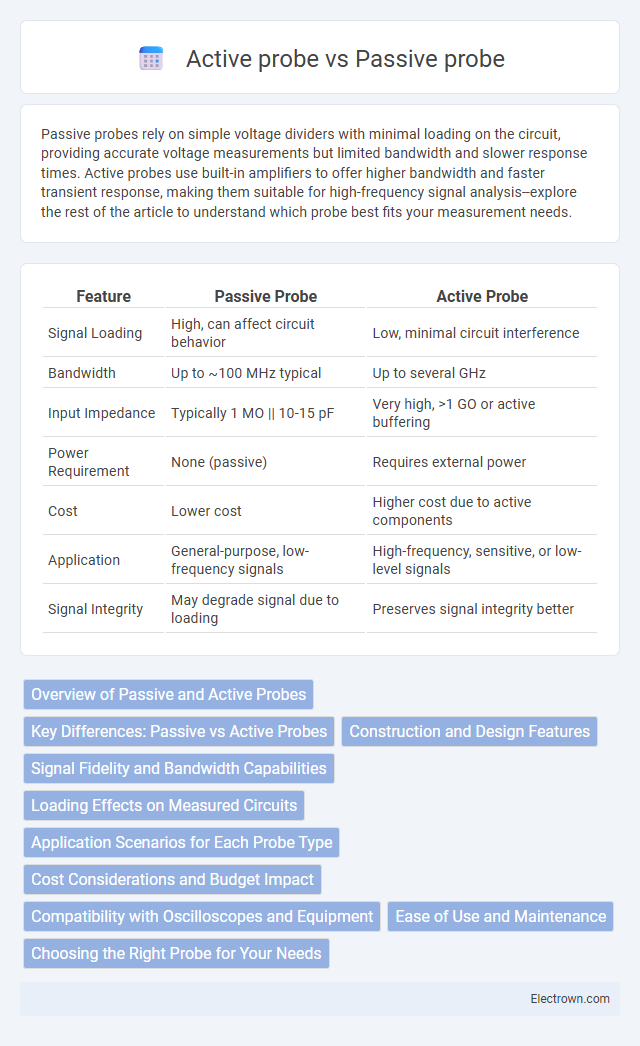Passive probes rely on simple voltage dividers with minimal loading on the circuit, providing accurate voltage measurements but limited bandwidth and slower response times. Active probes use built-in amplifiers to offer higher bandwidth and faster transient response, making them suitable for high-frequency signal analysis--explore the rest of the article to understand which probe best fits your measurement needs.
Table of Comparison
| Feature | Passive Probe | Active Probe |
|---|---|---|
| Signal Loading | High, can affect circuit behavior | Low, minimal circuit interference |
| Bandwidth | Up to ~100 MHz typical | Up to several GHz |
| Input Impedance | Typically 1 MO || 10-15 pF | Very high, >1 GO or active buffering |
| Power Requirement | None (passive) | Requires external power |
| Cost | Lower cost | Higher cost due to active components |
| Application | General-purpose, low-frequency signals | High-frequency, sensitive, or low-level signals |
| Signal Integrity | May degrade signal due to loading | Preserves signal integrity better |
Overview of Passive and Active Probes
Passive probes provide a simple, cost-effective solution for signal measurement with minimal circuitry, ideal for low-frequency or less sensitive applications. Active probes incorporate built-in amplifiers and impedance buffers, enabling accurate measurement of high-frequency or low-amplitude signals with minimal loading effect on the circuit. Your choice between passive and active probes depends on factors like signal frequency, amplitude, and required measurement accuracy.
Key Differences: Passive vs Active Probes
Passive probes have a simple design with high impedance and low capacitance, ensuring minimal circuit loading but limited bandwidth and signal integrity. Active probes incorporate an active circuit, usually a FET or op-amp, providing low input capacitance, higher bandwidth, and better signal fidelity for high-frequency or low-level signals. The main differences between passive and active probes lie in their input impedance, bandwidth, signal distortion, and suitability for measuring sensitive or high-speed signals.
Construction and Design Features
Passive probes consist of a simple resistor and capacitor network with minimal circuitry, making them lightweight and less expensive, but they can introduce signal attenuation and loading effects. Active probes incorporate an integrated amplifier and sometimes a buffer stage near the probe tip, enhancing bandwidth and signal integrity by reducing the capacitive load on the measured circuit. Your choice between passive and active probes depends on the required measurement accuracy, bandwidth, and the sensitivity of your device under test.
Signal Fidelity and Bandwidth Capabilities
Passive probes offer high signal fidelity with minimal circuit loading but are limited in bandwidth, typically up to a few hundred MHz, making them suitable for low to mid-frequency signals. Active probes incorporate built-in amplification to maintain signal integrity at higher frequencies, delivering higher bandwidth capabilities often reaching several GHz, which preserves your signal's fast transient details with greater accuracy. Choosing between them depends on your need for accuracy in high-speed signal measurements and the acceptable trade-off in circuit loading and complexity.
Loading Effects on Measured Circuits
Passive probes introduce higher capacitive and resistive loading on the measured circuit due to their simple resistor-capacitor network, which can affect signal integrity and distort high-frequency measurements. Active probes utilize internal amplification and buffer stages, significantly reducing the loading effect by presenting a high input impedance and low input capacitance, preserving signal fidelity in sensitive or high-speed circuits. Choosing an active probe is essential for accurate measurements in circuits where loading effects from passive probes could alter operational behavior or timing characteristics.
Application Scenarios for Each Probe Type
Passive probes are commonly used in low-frequency circuit testing and measurement scenarios where signal integrity is less critical, such as analog signal analysis and general-purpose troubleshooting. Active probes excel in high-frequency and high-speed digital applications, offering minimal loading effects and accurate measurements in complex RF circuits and high-bandwidth signal environments. Choosing between passive and active probes depends on factors like signal frequency, impedance requirements, and measurement accuracy needed for specific test applications.
Cost Considerations and Budget Impact
Passive probes generally have a lower upfront cost and simpler design, making them a budget-friendly choice for standard measurement tasks. Active probes, while more expensive due to their integrated amplification and higher bandwidth capabilities, can reduce overall costs by minimizing measurement errors and improving accuracy in complex or high-frequency applications. Your budget impact depends on application requirements and whether performance benefits justify the higher price of active probes.
Compatibility with Oscilloscopes and Equipment
Passive probes offer wide compatibility with most oscilloscopes due to their simple design and standard 1X or 10X attenuation settings, making them suitable for general-purpose measurements. Active probes require specific oscilloscope inputs, often with dedicated power supplies or connectors, to fully utilize their high-frequency and low-capacitance benefits. Your oscilloscope's bandwidth and input impedance must align with the probe type to ensure accurate and reliable signal acquisition.
Ease of Use and Maintenance
Passive probes offer simplicity with minimal maintenance due to their straightforward design and no need for power, making them easy to use for quick measurements. Active probes, while requiring power and occasional calibration, provide better signal integrity but demand more attention to upkeep and handling. Your choice depends on balancing ease of use with the precision and maintenance requirements of your measurement tasks.
Choosing the Right Probe for Your Needs
Passive probes offer simplicity and affordability with minimal signal distortion, making them ideal for general-purpose measurements and low-frequency signals. Active probes provide higher bandwidth and lower input capacitance, essential for accurate testing of high-speed or high-frequency circuits where signal integrity is critical. Selecting your probe depends on balancing cost, frequency requirements, and the sensitivity of your measurement environment.
Passive probe vs Active probe Infographic

 electrown.com
electrown.com